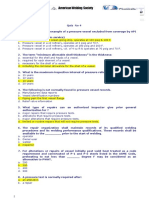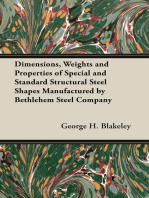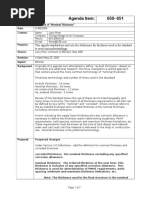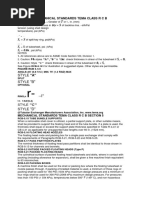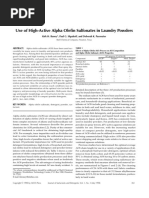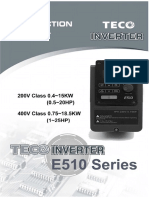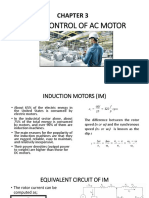API 650 12th - 2013
API 650 12th - 2013
Uploaded by
mechkourCopyright:
Available Formats
API 650 12th - 2013
API 650 12th - 2013
Uploaded by
mechkourOriginal Title
Copyright
Available Formats
Share this document
Did you find this document useful?
Is this content inappropriate?
Copyright:
Available Formats
API 650 12th - 2013
API 650 12th - 2013
Uploaded by
mechkourCopyright:
Available Formats
WELDED TANKS FOR OIL STORAGE 5-15
5.5 Annular Bottom Plates
5.5.1 When the bottom shell course is designed using the allowable stress for materials in Group IV, IVA, V, or VI,
butt-welded annular bottom plates shall be used (see 5.1.5.6). When the bottom shell course is of a material in Group
IV, IVA, V, or VI and the maximum product stress (see 5.6.2.1) for the first shell course is less than or equal to 160
MPa (23,200 lbf/in.2) or the maximum hydrostatic test stress (see 5.6.2.2) for the first shell course is less than or
equal to 171 MPa (24,900 lbf/in.2), lap-welded bottom plates (see 5.1.5.4) may be used in lieu of butt-welded annular
bottom plates.
5.5.2 Annular bottom plates shall have a radial width that provides at least 600 mm (24 in.) between the inside of the
shell and any lap-welded joint in the remainder of the bottom. Annular bottom plate projection outside the shell shall
meet the requirements of 5.4.2. A greater radial width of annular plate is required when calculated as follows:
In SI units:
215 t b
-----------------
-
0.5
HG
where
tb is the thickness of the annular plate (see 5.5.3), in mm;
H is the maximum design liquid level (see 5.6.3.2), in m;
G is the design specific gravity of the liquid to be stored.
In USC units:
390 t b
-----------------
-
0.5
HG
where
tb is the thickness of the annular plate (see 5.5.3), in inches;
H is the maximum design liquid level (see 5.6.3.2), in feet;
G is the design specific gravity of the liquid to be stored.
5.5.3 The thickness of the annular bottom plates shall not be less than the greater thickness determined using Table
5.1a and Table 5.1b for product design (plus any specified corrosion allowance) or for hydrostatic test design. Table
5.1a and Table 5.1b are applicable for effective product height of H G 23 m (75 ft). Beyond this height an elastic
analysis must be made to determine the annular plate thickness.
5.5.4 The ring of annular plates shall have a circular outside circumference, but may have a regular polygonal
shape inside the tank shell, with the number of sides equal to the number of annular plates. These pieces shall be
welded in accordance with 5.1.5.6 and 5.1.5.7, Item b.
5.5.5 In lieu of annular plates, the entire bottom may be butt-welded provided that the requirements for annular plate
thickness, welding, materials, and inspection are met for the annular distance specified in 5.5.2.
You might also like
- API 510 QUIZ No.4 With AnswersDocument5 pagesAPI 510 QUIZ No.4 With AnswersHatem Ragab100% (2)
- Procedure of Tank RepairDocument4 pagesProcedure of Tank RepairCepi Sindang KamulanNo ratings yet
- Backing BearingsDocument8 pagesBacking BearingsJurun_BidanshiNo ratings yet
- STD 159Document34 pagesSTD 159sparkarc4100% (2)
- Dimensions, Weights and Properties of Special and Standard Structural Steel Shapes Manufactured by Bethlehem Steel CompanyFrom EverandDimensions, Weights and Properties of Special and Standard Structural Steel Shapes Manufactured by Bethlehem Steel CompanyNo ratings yet
- Analytical Trigonometry With Applications 1 PDFDocument192 pagesAnalytical Trigonometry With Applications 1 PDFmechkour100% (3)
- API Standard 650-Drip Ring For Tank Bottom PlatesDocument2 pagesAPI Standard 650-Drip Ring For Tank Bottom PlatesShankar Pl GowdaNo ratings yet
- Notes Api650Document6 pagesNotes Api650MasoodMiyanNo ratings yet
- Nozzle Dim 12th EdnDocument16 pagesNozzle Dim 12th EdnBTENo ratings yet
- API 650 PageDocument2 pagesAPI 650 PageGerry Dan ChanliongcoNo ratings yet
- 620 TiDocument12 pages620 Tijojo_323No ratings yet
- 650-1001 Rev 0 - Shell Manhole Cover Flange ThicknessDocument3 pages650-1001 Rev 0 - Shell Manhole Cover Flange ThicknessShayan Hasan KhanNo ratings yet
- 650 651rev4Document6 pages650 651rev4Aycan GürbüzNo ratings yet
- Design of Tank BottomsDocument5 pagesDesign of Tank Bottomsamalhaj2013No ratings yet
- API 650 Part 2 - 2001 Welded Tanks-2Document15 pagesAPI 650 Part 2 - 2001 Welded Tanks-2Hassan Ali SadiqNo ratings yet
- Specification For Stop ValvesDocument9 pagesSpecification For Stop ValvesstarykltNo ratings yet
- Design Criteria of Stilling BasinDocument22 pagesDesign Criteria of Stilling Basinjagmeet singh100% (1)
- Series 6: Valves & Wellhead Equipment: Standard Edition SectionDocument21 pagesSeries 6: Valves & Wellhead Equipment: Standard Edition SectionSarathiraja SekarNo ratings yet
- Angulo CoronamientoDocument1 pageAngulo CoronamientoJoel Pacheco DiazNo ratings yet
- API 650 - 2013 - 12th para 5.10.4Document2 pagesAPI 650 - 2013 - 12th para 5.10.4rudi 01No ratings yet
- Section 5 Mechanical Standards Tema Class R C B: StyleDocument195 pagesSection 5 Mechanical Standards Tema Class R C B: StyleASI.KHMEDNo ratings yet
- Single Row Deep Groove Ball Bearings of Generation C: Technical Product InformationDocument12 pagesSingle Row Deep Groove Ball Bearings of Generation C: Technical Product InformationsteelageNo ratings yet
- Finite Element Analysis For The Design Validation of Mounded LPG BulletsDocument8 pagesFinite Element Analysis For The Design Validation of Mounded LPG BulletsMuhammed NoufalNo ratings yet
- Dimensions in Millimeters: 5-68 Api S 650Document1 pageDimensions in Millimeters: 5-68 Api S 650Joel Pacheco DiazNo ratings yet
- API 650, Section 5 Design, 5.4.bottom PlateDocument1 pageAPI 650, Section 5 Design, 5.4.bottom PlateAndi Dedi Aris YaningratNo ratings yet
- 650 651rev4Document7 pages650 651rev4Seymur AkbarovNo ratings yet
- ASMEDocument7 pagesASMEASI.KHMED100% (1)
- Amendment No. 1 May 1988 Is: 778-1984 Specification For Copper Alloy Gate, Globe and Check Valves ForDocument2 pagesAmendment No. 1 May 1988 Is: 778-1984 Specification For Copper Alloy Gate, Globe and Check Valves ForThetarunNo ratings yet
- SneDocument28 pagesSneManojkumar ThilagamNo ratings yet
- TD-031 CFR Title 49 178.46 Specification 3AL Seamless Aluminum CylindersDocument11 pagesTD-031 CFR Title 49 178.46 Specification 3AL Seamless Aluminum CylindersswLuNo ratings yet
- 510 PC Oct04 Qar-Ex1 Closed PSJDocument5 pages510 PC Oct04 Qar-Ex1 Closed PSJCss SfaxienNo ratings yet
- KSB B: Deep Well Turbine Pump BDocument36 pagesKSB B: Deep Well Turbine Pump BKishore Krishna0% (1)
- Fisher FB and FBG Control Valves Bulletin PDFDocument24 pagesFisher FB and FBG Control Valves Bulletin PDFWalid FattahNo ratings yet
- 2.pressure Vessel Presentation by Kapidev ShindeDocument103 pages2.pressure Vessel Presentation by Kapidev ShindePratik WalheNo ratings yet
- Ss Bottom Plate Thickness MinmumDocument1 pageSs Bottom Plate Thickness MinmumSUNNY GUPTANo ratings yet
- TilTing Pad Radial BeaRings PDFDocument28 pagesTilTing Pad Radial BeaRings PDFmrbookaniNo ratings yet
- Bhel WF SpoolDocument4 pagesBhel WF SpoolDonna GrayNo ratings yet
- IS 15658 - AmendedDocument3 pagesIS 15658 - Amendedraviteja036No ratings yet
- Hyflo™ III Liner Packer With C-2™ Profile, Hyflo III Liner Packer With HR™ Profile, Hyflo™ III Liner Packer With RH™ ProfileDocument5 pagesHyflo™ III Liner Packer With C-2™ Profile, Hyflo III Liner Packer With HR™ Profile, Hyflo™ III Liner Packer With RH™ Profilemsm.ele2009No ratings yet
- Studded Outlet HSB News Letter PDFDocument4 pagesStudded Outlet HSB News Letter PDFG.SWAMINo ratings yet
- Is 13349Document20 pagesIs 13349raji357100% (1)
- ABS Rules For Building and Classing Steel Vessel, 2017: AlignmentDocument6 pagesABS Rules For Building and Classing Steel Vessel, 2017: AlignmentDavid MestanzaNo ratings yet
- API 510 QUIZ No.4Document5 pagesAPI 510 QUIZ No.4Hatem RagabNo ratings yet
- AD171 Partial Penetration Butt WeldsDocument3 pagesAD171 Partial Penetration Butt Weldsikirby77100% (1)
- Chapter 5, Plate Girders TTTTDocument21 pagesChapter 5, Plate Girders TTTTetsubdinkabeje3100% (1)
- Chapter 3 Volume 2 Section 3 General BA 36/90: GRC Flat Single SkinDocument8 pagesChapter 3 Volume 2 Section 3 General BA 36/90: GRC Flat Single SkinchatxxnoirNo ratings yet
- 4.2 Design of Welded Joints v3Document50 pages4.2 Design of Welded Joints v3adrianhhhh1984No ratings yet
- Shell Repairs To Storage Tanks Using LapDocument6 pagesShell Repairs To Storage Tanks Using LapMSNo ratings yet
- MATH Reinforced Concrete Design 01Document3 pagesMATH Reinforced Concrete Design 01Md. Zahid Hasan RubelNo ratings yet
- 650-728 Rev 4 Wind Girder Section ModulusDocument16 pages650-728 Rev 4 Wind Girder Section Modulusalilou2013No ratings yet
- Section 5Document30 pagesSection 5Orgil OrgilsaihanNo ratings yet
- API 650, Section 5 Design, 5.10.roof 2Document1 pageAPI 650, Section 5 Design, 5.10.roof 2Andi Dedi Aris YaningratNo ratings yet
- 500 Shell Design PDFDocument28 pages500 Shell Design PDFaliNo ratings yet
- Steel Flooring SystemDocument9 pagesSteel Flooring SystemAndrea GibsonNo ratings yet
- BAY.t-510 Open Prac Exam #3Document14 pagesBAY.t-510 Open Prac Exam #3Karim MamdouhNo ratings yet
- BRG Pad ExampleDocument16 pagesBRG Pad ExamplecarlosestayNo ratings yet
- SM60427 PDFDocument26 pagesSM60427 PDFHENKO7659No ratings yet
- Goodyear GA-28A/B Convoy Fighter: The Naval VTOL Turboprop Tailsitter Project of 1950From EverandGoodyear GA-28A/B Convoy Fighter: The Naval VTOL Turboprop Tailsitter Project of 1950Rating: 4 out of 5 stars4/5 (2)
- TEREX AC100/4L: Rans ANU AchinesDocument5 pagesTEREX AC100/4L: Rans ANU AchinesmechkourNo ratings yet
- Instructions D'Installation Et D'Enlèvement: Lève-VitreDocument14 pagesInstructions D'Installation Et D'Enlèvement: Lève-VitremechkourNo ratings yet
- 650 Rev.02 ITP With Plan at Site (API 650 Tanks) PDFDocument41 pages650 Rev.02 ITP With Plan at Site (API 650 Tanks) PDFMohamed Abd El DayemNo ratings yet
- 94 NDS 7Document227 pages94 NDS 7mechkourNo ratings yet
- 119 Control ValveDocument16 pages119 Control ValvemechkourNo ratings yet
- Limit Exp PDFDocument1 pageLimit Exp PDFmechkourNo ratings yet
- 1composition 1er Trimestre Lyce Ibn Khatab 2007 2008Document2 pages1composition 1er Trimestre Lyce Ibn Khatab 2007 2008mechkourNo ratings yet
- Readme-And-Serial - Cadworx2018 PDFDocument1 pageReadme-And-Serial - Cadworx2018 PDFmechkourNo ratings yet
- 852b PDFDocument12 pages852b PDFmechkourNo ratings yet
- Instruction: Multipliez Chaque Nombre Par Lui-MêmeDocument2 pagesInstruction: Multipliez Chaque Nombre Par Lui-MêmemechkourNo ratings yet
- Complexeserie3 Solution PDFDocument3 pagesComplexeserie3 Solution PDFmechkourNo ratings yet
- TOPIC 3: Solving EquationsDocument4 pagesTOPIC 3: Solving EquationsXaronAngelNo ratings yet
- Aptomat C65N Multi - 9 - 17951Document2 pagesAptomat C65N Multi - 9 - 17951TaQuangDucNo ratings yet
- Chap004 - CH4 Solution of Power Electronics by Daniel W.Hart Chap004 - CH4 Solution of Power Electronics by Daniel W.HartDocument30 pagesChap004 - CH4 Solution of Power Electronics by Daniel W.Hart Chap004 - CH4 Solution of Power Electronics by Daniel W.HarthassanNo ratings yet
- Use of High-Active Alpha Olefin Sulfonates in Laundry PowdersDocument9 pagesUse of High-Active Alpha Olefin Sulfonates in Laundry PowdersJuan Camilo RodriguezNo ratings yet
- Prim Maths 3 2ed TR Diagnostic CheckDocument7 pagesPrim Maths 3 2ed TR Diagnostic Checkhninwuthmon93No ratings yet
- Line Distance Protection IED REL 670Document47 pagesLine Distance Protection IED REL 670kass_ecs100% (1)
- Reexamination of PDC Bit Walk in Directional and Horizontal WellsDocument12 pagesReexamination of PDC Bit Walk in Directional and Horizontal WellsFairuz AthallahNo ratings yet
- ProductSerieSheet 3CNV enDocument3 pagesProductSerieSheet 3CNV enSyamsul SetyawanNo ratings yet
- CPT For SI Quality ControlDocument29 pagesCPT For SI Quality Control_seeNo ratings yet
- E510 Manual (English) V04Document213 pagesE510 Manual (English) V04benderpoaNo ratings yet
- PowerstationDocument1 pagePowerstationMuhammad Afiszal Bin FadzilNo ratings yet
- TDS Piezotech FC 2018Document12 pagesTDS Piezotech FC 2018aymanelaslamiNo ratings yet
- Instruction Manual: LX70/700 Multi-Wire Link ModuleDocument22 pagesInstruction Manual: LX70/700 Multi-Wire Link ModuleVirendra ZopeNo ratings yet
- 06 FlamephotometerDocument10 pages06 FlamephotometerHassan GillNo ratings yet
- Quantum Entanglement What Is It & Why Is It ImpoDocument1 pageQuantum Entanglement What Is It & Why Is It ImpoDheeraj UppinNo ratings yet
- An Elementary Construction of The Geometric Algebra - Alan MacdonaldDocument7 pagesAn Elementary Construction of The Geometric Algebra - Alan MacdonaldBruno dos SantosNo ratings yet
- Dental Polymers: Typical Applications of Polymers in DentistryDocument9 pagesDental Polymers: Typical Applications of Polymers in DentistryEuro UndisaNo ratings yet
- QP - ESE - S22 - ME - MET704 - Smart Manufacturing SystemDocument2 pagesQP - ESE - S22 - ME - MET704 - Smart Manufacturing SystemPRADEEP GUPTANo ratings yet
- 2011 NEC Code 310.15B3cDocument7 pages2011 NEC Code 310.15B3cKhaldoon AlnashiNo ratings yet
- Basic Mechanical Design CalculationsDocument6 pagesBasic Mechanical Design CalculationsSaroj Kumar MangarajNo ratings yet
- Kine Chap 1 Part 3 Levers and PulleyDocument41 pagesKine Chap 1 Part 3 Levers and PulleyAzfar Khurshid MalghaniNo ratings yet
- Motor Leeson EtiquetadoDocument4 pagesMotor Leeson EtiquetadoSINAGUSNo ratings yet
- Structural and Electronic Properties of Tellurite Glasses: Journal of Materials Science June 2009Document7 pagesStructural and Electronic Properties of Tellurite Glasses: Journal of Materials Science June 2009aisyahNo ratings yet
- Module - 3 Partial Differential EquationsDocument23 pagesModule - 3 Partial Differential Equationsprajwal basavaiahNo ratings yet
- 2021 - SM015 - Prepspm - Set 3Document4 pages2021 - SM015 - Prepspm - Set 3AQEESHA NUWAIRA BINTI USMAN BN21110154No ratings yet
- PDF Question Bank in Ac CircuitsDocument75 pagesPDF Question Bank in Ac CircuitsDelos Santos, Jayson C.No ratings yet
- Re 17327 - 2022-12Document36 pagesRe 17327 - 2022-12Abner TortoreliNo ratings yet
- Chapter 3 DET50063 - SPEED CONTROL OF AC MOTORDocument19 pagesChapter 3 DET50063 - SPEED CONTROL OF AC MOTORFara FaraNo ratings yet
- Tut4 MatLab SignalsSystems2021Document2 pagesTut4 MatLab SignalsSystems2021Huy Vũ GiaNo ratings yet
- Copia de VF7 Doc 2017Document25 pagesCopia de VF7 Doc 2017Edgar ZamoraNo ratings yet
